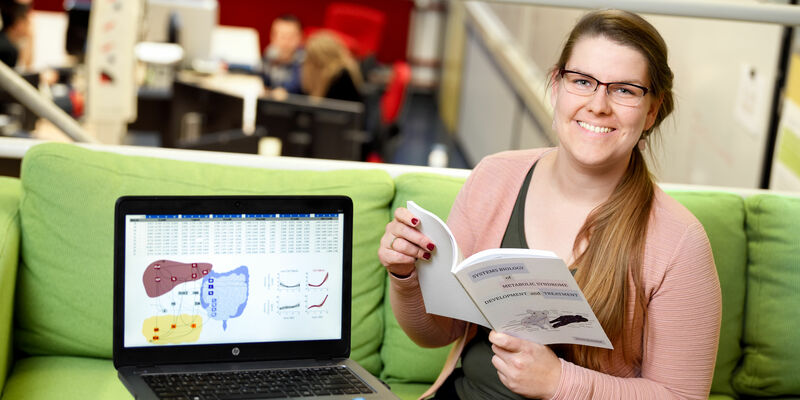
- Home Stretch , Research
- 30/11/2018
Home Stretch | Risks of being overweight
Overweight often goes hand in hand with disorders like diabetes and cardiovascular disease. Yet not everyone who is too heavy is at immediate risk of health problems: whether someone with obesity is actually in the danger zone depends on the extent to which his or her metabolism is not functioning properly. Using computer models and special mice, doctoral candidate Yvonne Rozendaal aimed to throw more light on this complex topic.
Carrying extra weight, an overly high sugar level, abnormal cholesterol values, fat in the blood and high blood pressure: if at least three factors in this list apply to you, you are suffering from ‘metabolic syndrome’ and you run a strong risk of developing such conditions as diabetes or cardiovascular disease. At least, this is the rule of thumb currently being applied in medical science.
The differences between people are so great, however, that the predictive value of this rule of thumb is limited for any one individual, tells doctoral candidate Yvonne Rozendaal. “It is estimated that 10 to 30 percent of people with obesity have a completely healthy metabolism, and so are not exposed to any additional risk.”
Intervention
As we learn more about the consequences of overweight for an individual's metabolism, we may be able to intervene at an earlier stage, or even develop drugs that combat these consequences. This idea underpins the European project RESOLVE, in which Rozendaal conducted her doctoral research. She combined detailed computer models of the human metabolism with experiments involving mice whose metabolism was as similar to a person's as possible, achieved with genetic manipulation.
“The tricky thing about metabolic syndrome is that it develops very gradually,” explains the PhD candidate. “In order to study its development in people, you would have to follow individuals over many years.” In mice, by contrast, the same process, from the first weight gain to severe symptoms, lasts only three months. And that makes the laboratory mouse an interesting object of study.
The problem, however, is that mice have a very different metabolism from people. According to Rozendaal, the balance between the two types of cholesterol in mice is exactly the reverse of the balance in people. She therefore used a very special mouse, described by the code APOE*3-Leiden.CEPT, which due to a genetic intervention is a good model for human metabolism.
Differences
It turned out that the mice studied fell into two categories. After having been fattened up considerably, some indeed had a highly elevated fat content in the blood and abnormal cholesterol values, but for other mice these values were only slightly higher than normal. “Among the first group, we saw that the liver was more active than in the second group, while the latter group were absorbing much less cholesterol from the food.”
While all the mice were overweight to the same degree - and had the same elevated blood sugar level - there were thus considerable differences in their digestion. “That was quite surprising, because these laboratory animals are very closely related genetically. Thus metabolic syndrome appears to be much more complicated than we thought.”
Although she will gain her doctorate shortly before Christmas, Rozendaal has already started work at Philips Research, where she is applying her knowledge of complex biological models to tumors. After all, the individual approach is becoming increasingly important in the fight against cancer: tumors are analyzed at the molecular level in order to identify the right medication. “What's nice about this work is that it is closer to the application, and the reason why you are doing it is immediately obvious.”
Discussion